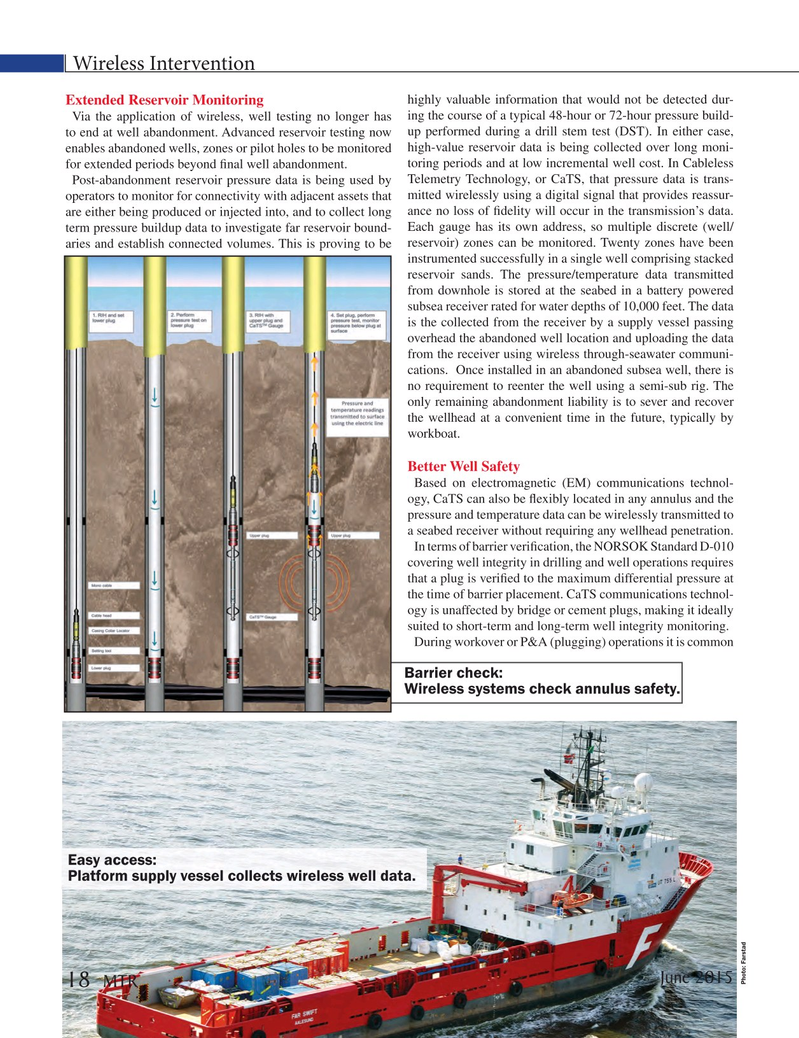
Page 18: of Marine Technology Magazine (June 2015)
Hydrographic Survey
Read this page in Pdf, Flash or Html5 edition of June 2015 Marine Technology Magazine
Wireless Intervention highly valuable information that would not be detected dur-
Extended Reservoir Monitoring
Via the application of wireless, well testing no longer has ing the course of a typical 48-hour or 72-hour pressure build- to end at well abandonment. Advanced reservoir testing now up performed during a drill stem test (DST). In either case, enables abandoned wells, zones or pilot holes to be monitored high-value reservoir data is being collected over long moni- for extended periods beyond ? nal well abandonment. toring periods and at low incremental well cost. In Cableless
Post-abandonment reservoir pressure data is being used by Telemetry Technology, or CaTS, that pressure data is trans- operators to monitor for connectivity with adjacent assets that mitted wirelessly using a digital signal that provides reassur- are either being produced or injected into, and to collect long ance no loss of ? delity will occur in the transmission’s data. term pressure buildup data to investigate far reservoir bound- Each gauge has its own address, so multiple discrete (well/ aries and establish connected volumes. This is proving to be reservoir) zones can be monitored. Twenty zones have been instrumented successfully in a single well comprising stacked reservoir sands. The pressure/temperature data transmitted from downhole is stored at the seabed in a battery powered subsea receiver rated for water depths of 10,000 feet. The data is the collected from the receiver by a supply vessel passing overhead the abandoned well location and uploading the data from the receiver using wireless through-seawater communi- cations. Once installed in an abandoned subsea well, there is no requirement to reenter the well using a semi-sub rig. The only remaining abandonment liability is to sever and recover the wellhead at a convenient time in the future, typically by workboat.
Better Well Safety
Based on electromagnetic (EM) communications technol- ogy, CaTS can also be ? exibly located in any annulus and the pressure and temperature data can be wirelessly transmitted to a seabed receiver without requiring any wellhead penetration.
In terms of barrier veri? cation, the NORSOK Standard D-010 covering well integrity in drilling and well operations requires that a plug is veri? ed to the maximum differential pressure at the time of barrier placement. CaTS communications technol- ogy is unaffected by bridge or cement plugs, making it ideally suited to short-term and long-term well integrity monitoring.
During workover or P&A (plugging) operations it is common
Barrier check:
Wireless systems check annulus safety.
Easy access:
Platform supply vessel collects wireless well data.
June 2015
Photo: Farstad 18 MTR
MTR #5 (18-33).indd 18 MTR #5 (18-33).indd 18 6/11/2015 9:52:45 AM6/11/2015 9:52:45 AM

 17
17

 19
19
